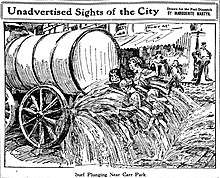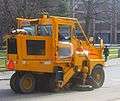Street sweeper
A street sweeper or street cleaner may refer to a person's occupation, or a machine that cleans streets. A street sweeper cleans the streets, usually in an urban area.



Street sweepers have been employed in cities as "sanitation workers" since sanitation and waste removal became a priority. A street-sweeping person would use a broom and shovel to clean off litter, animal waste and filth that accumulated on streets. Later, water hoses were used to wash the streets.
Machines were created in the 19th century to do the job more efficiently. Today, modern street sweepers are mounted on truck bodies and can vacuum debris that accumulates in streets.
Modern sweepers

Newer street sweepers are capable of collecting small particles of debris.[1] Many street sweepers produced today are PM10 and PM2.5 certified,[2] meaning that they are capable of collecting and holding particulate matter sized less than 10μm and even down to 2.5μm.[3] Despite advancements in street sweeping technology, the mechanical broom type street sweeper accounts for approximately 90 percent of all street sweepers used in the United States today.[4] In 2018, Boschung, a Swiss street sweeper manufacturer, launched the Urban-Sweeper S2.0, the first fully electric street sweeper releasing 0 (zero) emissions.
History
Manual sweeping
The need for rubbish to be removed from roads in built-up areas has existed for centuries.
Sometimes a local law in a town or city ordered the owner of occupier of each address to clean the length of that road that passed his address.
Sometimes when much traffic was horse-drawn vehicles or ridden horses, there were street cleaners who selectively removed horse droppings because of their value as fertilizer on nearby rural areas.
Mechanical sweepers in the United Kingdom
By the 1840s, Manchester, England, had become known as the first industrial city. Manchester had one of the largest textile industries of that time. As a result, the robust metropolis was said to be England’s unhealthiest place to live.[5] In response to this unsanitary environment, Joseph Whitworth invented the mechanical street sweeper. The street sweeper was designed with the primary objective to remove rubbish from streets in order to maintain aesthetic goals and safety.[1][2]
Mechanical sweepers in the United States
The very first street sweeping machine was patented in 1849 by its inventor, C.S. Bishop. For a long time, street sweepers were just rotating disks covered with wire bristles. These rotating disks served as mechanical brooms that swept the dirt on the streets.[6]
A common misconception is that Charles Brooks invented the street sweeper in America in 1896. Brooks' design, far from being the "first street sweeper," was just a variation of what already existed, and the patent for it was among the more than 300 street sweeper patents issued in the United States before 1900. Most 19th-century sweepers, including the one in Brooks' patent, were horsecarts with no engine on board. The wheels on the cart turned gears or chains which drove the brush and belt. The first self-propelled sweeper vehicle patented in the US, driven by a steam engine and intended for cleaning railroad tracks, was patented in 1868, patent No. 79606. Eureka C. Bowne was the first known woman to get a patent for a street sweeper, in 1879, patent No. 222447. "Her success was great", wrote Matilda Joslyn Gage in The North American Review, volume 136, issue 318, May 1883.[7]
John M. Murphy called at the offices of American Tower and Tank Company in Elgin, Illinois, in the fall of 1911. He had a plan of a motor-driven pickup street sweeper. The American Tower and Tank Company had been formed in 1903 by Charles A. Whiting and James Todd. They called in a recently acquired silent partner, Daniel M. Todd, and it was decided to hire Murphy and begin the development of his idea. That started what has become the Elgin Sweeper Company.[8]
After two years of trial, development, experimentation, and research, a sweeper was achieved which Murphy was satisfied performed all of the sweeping functions in the manner he had envisioned – one which partners James and Daniel M. Todd and Charles A. Whiting were willing to risk a reputation gained from 30 years' manufacturing experience.[8]
In the fall of 1913, the city of Boise, Idaho, purchased the first Elgin Sweeper, following a demonstration. Boise Street Commissioner, Thomas Finegan, made a comparison showing a savings of $2,716.77 from the Elgin motorized sweeper when used rather than a horse-drawn sweeper.[8]
Following its introduction and initial sales, Murphy continued improving his sweeper. In 1917, US patents were filed and issues for J. M. Murphy, Street Sweeping machine No. 1,239,293.[8]
Technological advancement
The goal of simple debris removal did not change until the 1970s, when policymakers begun to reflect concern for water quality. In the United States, the lag time in which street sweepers responded can be pinpointed to the Runoff Report of 1998.[9] As older street sweepers were only effective in removing large particles of road debris, small particles of debris remained behind in large quantities.[10] The remaining debris was not seen as an aesthetic issue because rain would wash them away. Today, small particles are known to carry a substantial portion of the stormwater pollutant load.
Street sweeping can be an effective measure in reducing pollutants in stormwater runoff.[11] The Environmental Protection Agency considers street sweeping the best practice in protecting water quality.
See also
References
- Pitt R, Bannerman R, Sutherland R, 2004. The role of street cleaning in stormwater management, Environmental and Water Resources Institute of the American Society of Civil Engineers. 1-8
- Chang Y, Chou C, Su K, Tseng C, 2004. Effectiveness of street sweeping and washing for controlling ambient TSP, Atmospheric Environment, 39: 1891–1902
- PM-10 Efficient Street Sweepers
- Wildlife and Habitat | Ecosystems | Environmental Review Toolkit | FHWA
- "A Brief History of Manchester".
- "Archived copy". Archived from the original on 2011-12-30. Retrieved 2011-07-17.CS1 maint: archived copy as title (link)
- http://www.worldsweeper.com/History/ElevatorSweeperHistory.html
- (Source of Historic Information, The Sweep of Time by William A. Richman, 1962) (Information taken from published book)
- "Results of the Nationwide Urban Runoff Program" (PDF). Environmental Protection Agency. Retrieved 2013-12-16.
- German, J.; Svensson, G. (2002). "Metal content and particle size distribution of street sediments and street sweeping waste". Water Science and Technology. 46 (6–7): 191–198. Archived from the original on 2013-12-17.
- EPA - Stormwater Menu of BMPs Archived 2012-02-22 at the Wayback Machine
External links
| Wikimedia Commons has media related to Street sweepers. |
- Page, Walter Hines; Page, Arthur Wilson (April 1916). "Man And His Machines: Motor-Cycle Street Sweeper". The World's Work: A History of Our Time. XXXI: 694. Retrieved 2009-08-04.




